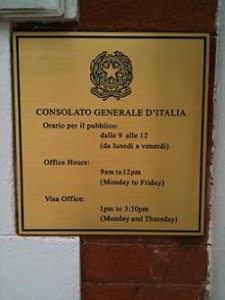Street signs are so much a part of city life; it’s very easy to take them for granted. At the corner of any street of consequence back home, you’d find a post from which hangs, or sticks out, a sign that indicates the name of the street. In the case of some low cost subdivisions, the subdivision block number would substitute as a street name. Some signs were large and fancy, with reflective coatings. Others were more austere.
But you could always count on these rectangle-shaped signs to be where they needed to be, and to look the way you expect; as surely as the sun’s rise in the morning, and its replacement by the moon at night. After all, why would anyone do it any other way, right?
Ah . . . assumptions . . . assumptions.
My first overseas destination, Taiwan, was a harbinger of things to come. For one thing, naming conventions there were different. Major thoroughfares were called “roads”. My company’s Taipei office, for example, was situated along Tun Hwa North Road, which could be loosely likened to a wider version of Ayala Avenue in the Makati Central Business District. Yet it was still called a “road”. “Streets” were smaller than roads, and relatively less prominent. Small alleys and side-streets were called “Lanes”.
 |
 |
Taiwanese roads were divided into sections and compass directions relative to a point of reference — a concept that has no Philippine equivalent. This was designed to give people a rough idea where on the road they were. Tun Hwa, for example was divided into North and South by its intersection with another road: ZhongXiao. The further away from the intersection you were, you’d transition to different section numbers. Our office, again as an example, was at the southern end of Tun Hwa called Section 2. Other roads ran from East to West. Some had as many as 7 sections which actually stretched outside Taipei City, deep into Taipei County.
Taipei street signs were also squarer than rectangular. They had to be, because they were bilingual. In keeping with efforts to make the Taiwanese capital an international city, English approximations of Chinese street names, and Hindu-Arabic numerals were included in all signs as an accommodation for the city’s foreign residents.
Canadian streets, at least in Ottawa, had an interesting implementation of a bilingual street naming policy. Since the street names were the same for both French and English, and utilized the same letters, it was a simple matter of adding “St.” and the French equivalent “Rue”. The following photo taken near Parliament Hill shows how they do it.
 |
The Irish like to put both old-Irish and English names of their streets on their signs, as with the sign below for St. Patrick St. in Cork, Ireland.
 |
The photo above also captures a common theme amongst European signs. They often use plaques mounted on the sides of buildings. I first noticed them on a trip to Paris. I didn’t immediately recognize them for what they were, because I instinctively associated signs with posts. It also didn’t help that at the time I hadn’t done my homework and figure out that “Rue” was French for street.
Once I wrapped my head around the fact that the street-name-on-a-post was not a “sacred” rule by any stretch of the imagination, Irish and more recently Italian, street plaques were less of a surprise.
Assumptions are funny things. Sometimes, you can’t even distinguish between fact and assumption because it never occurs to you to re-verify what you’ve already accepted as gospel truth. The nice thing about visa-collecting is that you’re often forced into situations that make re-verification necessary.
I wonder which assumption will be challenged next.
